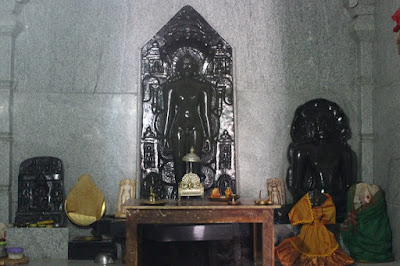This small town today is known for the cement plant but it has its own history. Some of the ancient temples are Panchalingeshwara Gudi, Manvikeshwara Gudi and Bananti Kambha, Jain Basadi, Kottala Basaveshwara Gudi, Madhava Trilingeshwara Eshwara temple, Jwalamukhi statues, Ganapa Navakoti Narayana Temple, Karadagiri Hanuman Temple, Laxmi Narayan temple, Hingulambika temple and few mosques and Dargahs. It is said that there are Jain cave ruins possibly created during Rashtrakuta times.
July 2, 2016
Our journey started early morning; first planned stop was Sedam. I wanted to check out the ancient temples of this place which was known as Sedimba long time back. We reached Sedam by 8-30; on my list were Laxmi Narayan temple, Panchalingeshwara Gudi, Manvikeshwara Gudi and Bananti Kambha, Jain Basadi and Kottala Basaveshwara Gudi. We entered the town, drove past main bus-stand heading towards railway station. As we drove deeper into the town, streets got narrower.. we found Laxmi Narayan temple; only two pujari were there; neither had any info about this temple's history. By the way, the temple though old had too many modern touches. We moved on towards Panchalingeshwara Gudi; the temple is located on slightly elevated part of the old town, it was crazy driving through the narrow streets, barely wide enough for a car and bike to pass each other. We managed to reach Panchalingeshwara Gudi, the abode of five Linga.

This temple is located close to the eastern edge of Sedam town where a stream flows in a curve. Turning our attention to the temple complex. It a group of four temples. The complex's gateway is richly decorated with a an arch, pair of Dwarapalas guarding the entrance. As we step in, there's one temple straight ahead...
..and another on the right hand side.
This how close both temples are. As you see both temples's entrances are similar, both have Dwarapalas of their own but while one pair is male the other pair is female. It is said these temples were built during Kalyana Chalukyas time.
Visitors are greeted by Dwarapalas covered in heavy ornaments from head to toe. Wonder if the sculptures were purely made from imagination or if there were models to replicate. Anyway, the sculptures of these temples are amazing!
This is the four pillared Mantapa; beyond is the vestibule's mesh. The Mantapa's pillar design is pretty complex with so many sections.. square, octagonal and circular. Some sections are decorated with intricate designs.. designs copied by jewellery designers of our times.
Another view of the Mantapa.
One of the pillars had an interesting sculpture.. five men with seven legs. Cool imagination. When you look at any of the men, it seems to have a pair of legs.. don't look at the feet :)
Nandi mounted on a pedestal.
Every work in these temples have carried out with great care and attention. Now, looking at this Basavanna, see the creases in the neck skin and veins sticking out on the snout. Just too good! Even this Basavanna is pampered with heavy chain of bells around its neck and shoulder.
A big Ganapati sitting peacefully with an oil lamp burning besides him. Notice the pair of peacocks on the pillar.
A very complex ceiling, Notice the central sculpture.. Never seen anything this complex before. No words to describe this beautiful work.
This is the third temple with a small idol of Linga placed on the Garbhagudi floor (see inset).
Here too Sabha Mantapa has four columns. I loved the upper portion of these pillars. To create the disc with ridges is seriously tough work.
This the fourth temple, seems like it was restored recently.
The complex is pretty compact with temples tightly packed together. There were few pieces of sculptures placed about, found one of them interesting (see inset). Temle care-takers shouldn't have painted these walls.. I heard lime eats into stones and weakens it eventually. Only plastered walls require a coat of 'Sunna.'
Sedam must have been an important place during Kalyana Chalukyan times. Glad to have seen this temple. Worth the time n effort.
Next on our list were
Manvikeshwara Gudi & Bananti Kambha and Jain Basadi.
.........


























































